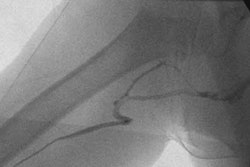NEW ORLEANS - A new system for carotid stenting and distal protection has proved itself in a prospective, multicenter trial, according to a presentation Sunday at the Society of Interventional Radiology (SIR) meeting.
The Carotid Revascularization with ev3 Arterial Technology Evolution (CREATE) trial tracked carotid artery stenting in 419 high-risk patients. The carotid stenting was done using the Protégé GPS nitinol stent and the Spider embolic protection device, both marketed by ev3 of Plymouth, MN, which funded the trial.
"The system allows use of an independent guidewire, which may increase technical success and reliability of achieving distal protection," wrote Dr. Robert Safian and colleagues in their SIR abstract.
The primary end point of the study was a 30-day major adverse cardiac event (MACE) rate, based on a composite of myocardial infarction, stroke, or death. In his presentation, Safian reported that the 30-day MACE rate was 4.8%.
Safian, who is the director of cardiac and vascular intervention at William Beaumont Hospital in Royal Oak, MI, said that the 30-day MACE rate compared favorably with the 7.8% 30-day MACE rate reported by the Acculink for Revascularization of Carotids in High Risk-Patients (ARCHeR) trials, and significantly better than the 11% to 15% 30-day MACE rates reported in endarterectomy trials.
Last month the U.S. Centers for Medicare and Medicaid Services (CMS) approved reimbursement for carotid stenting. But Medicare will only pay for carotid stenting in symptomatic patients, and only when it is done with the Acculink stent (Guidant, Indianapolis).
Sixty percent of the CREATE enrollees were male with a mean age of 74. Only 17% of the patients were symptomatic, but all the patients were considered high-risk: 23.3% had restenosis following endarterectomy, 14.3% had coronary artery disease in two or more vessels, 9.5% had a left ventricle ejection fraction of less than 35%, and 4% had severe pulmonary disease. More than one-third of the patients met two or more high-risk criteria, Safian said. Symptomatic patients had carotid stenosis of 50% or more, and asymptomatic patients had carotid stenosis of 70% or more.
Breaking down the 30-day MACE components, the results were 1% for mortality, 3.3% for any stroke, 2.3% for major stroke, and 0.5% for myocardial infarction. In addition, Safian said the trial's 30-day technical success rate was 97.8%.
Safian said the Protégé stent has several features that make it an operator-friendly device, including a locking mechanism that "fits together like pieces of a jigsaw puzzle to prevent stent lurching." When fully deployed, the stent doesn't shorten, he added.
When the trial registry was started, the stent was available in lengths of 20, 30, and 40 mm; while the trial was in progress, a 60-mm stent became available and was redesigned to be tapered. Safian said the longer stent was especially useful when "faced with a tubular lesion in a tortuous carotid," which would require placement of two or more shorter stents. The Spider embolic protection device is passed over the lesion prior to stent placement so that it can catch emboli downstream of the stent.
Safian predicted that the stent would gain FDA approval when one-year MACE rates and ipsilateral stroke rates are reported later this year.
By Peggy Peck
AuntMinnie.com contributing writer
April 5, 2005
Related Reading
Multimodal technique points to stroke candidates for late tPA, March 25, 2005
Postangioplasty carotid restenosis not tied to stroke, March 3, 2005
Copyright © 2005 AuntMinnie.com



















